Discover 35 hidden attractions, cool sights, and unusual things to do in Paris (France). Don't miss out on these must-see attractions: Champs-Élysées, Musée du Louvre, and Eiffel Tower. Also, be sure to include Notre-Dame de Paris in your itinerary.
Below, you can find the list of the most amazing places you should visit in Paris (Île-de-France).
Table of Contents
Champs-Élysées

Iconic site of landmarks, dining and shops. The Avenue des Champs-Élysées is an avenue in the 8th arrondissement of Paris, France, 1.9 kilometres long and 70 metres wide, running between the Place de la Concorde in the east and the Place Charles de Gaulle in the west, where the Arc de Triomphe is located. It is known for its theatres, cafés and luxury shops, as the finish of the Tour de France cycling race, as well as for its annual Bastille Day military parade. The name is French for the Elysian Fields, the place for dead heroes in Greek mythology. It is commonly regarded as the "most beautiful avenue in the world".[1]
Address: 27-33 avenue des Champs-Élysées, 75008 Paris (Élysée)
Musée du Louvre

Landmark art museum with vast collection. The Louvre, or the Louvre Museum, is the world's most-visited museum, and a historic landmark in Paris, France. It is the home of some of the best-known works of art, including the Mona Lisa and the Venus de Milo. A central landmark of the city, it is located on the Right Bank of the Seine in the city's 1st arrondissement. At any given point in time, approximately 38,000 objects from prehistory to the 21st century are being exhibited over an area of 72,735 square meters. Attendance in 2021 was 2.8 million due to the COVID-19 pandemic. The museum was closed for 150 days in 2020, and attendance plunged by 72 percent to 2.7 million. Nonetheless, the Louvre still topped the list of most-visited art museums in the world in 2021.
The museum is housed in the Louvre Palace, originally built in the late 12th to 13th century under Philip II. Remnants of the Medieval Louvre fortress are visible in the basement of the museum. Due to urban expansion, the fortress eventually lost its defensive function, and in 1546 Francis I converted it into the primary residence of the French Kings. The building was extended many times to form the present Louvre Palace. In 1682, Louis XIV chose the Palace of Versailles for his household, leaving the Louvre primarily as a place to display the royal collection, including, from 1692, a collection of ancient Greek and Roman sculpture. In 1692, the building was occupied by the Académie des Inscriptions et Belles-Lettres and the Académie Royale de Peinture et de Sculpture, which in 1699 held the first of a series of salons. The Académie remained at the Louvre for 100 years. During the French Revolution, the National Assembly decreed that the Louvre should be used as a museum to display the nation's masterpieces.
The museum opened on 10 August 1793 with an exhibition of 537 paintings, the majority of the works being royal and confiscated church property. Because of structural problems with the building, the museum was closed in 1796 until 1801. The collection was increased under Napoleon and the museum was renamed Musée Napoléon, but after Napoleon's abdication, many works seized by his armies were returned to their original owners. The collection was further increased during the reigns of Louis XVIII and Charles X, and during the Second French Empire the museum gained 20,000 pieces. Holdings have grown steadily through donations and bequests since the Third Republic. The collection is divided among eight curatorial departments: Egyptian Antiquities; Near Eastern Antiquities; Greek, Etruscan, and Roman Antiquities; Islamic Art; Sculpture; Decorative Arts; Paintings; Prints and Drawings.
The Musée du Louvre contains more than 380,000 objects and displays 35,000 works of art in eight curatorial departments with more than 60,600 square metres dedicated to the permanent collection. The Louvre exhibits sculptures, objets d'art, paintings, drawings, and archaeological finds.[2]
Address: Rue de Rivoli, 75001 Paris (Louvre)
Eiffel Tower
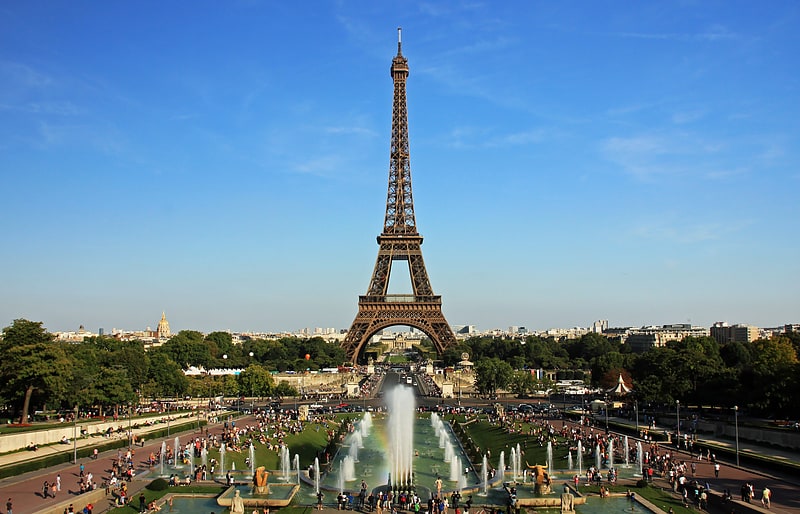
Also known as: Tour Eiffel
Landmark 324m-high 19th-century tower. The Eiffel Tower is a wrought-iron lattice tower on the Champ de Mars in Paris, France. It is named after the engineer Gustave Eiffel, whose company designed and built the tower.
Locally nicknamed "La dame de fer" (French for "Iron Lady"), it was constructed from 1887 to 1889 as the centerpiece of the 1889 World's Fair and was initially criticized by some of France's leading artists and intellectuals for its design, but it has become a global cultural icon of France and one of the most recognizable structures in the world. The Eiffel Tower is the most visited monument with an entrance fee in the world; 6.91 million people ascended it in 2015. The Tower was made a Monument historique in 1964 and named part of UNESCO World Heritage Site ("Paris, Banks of the Seins") in 1991.
The tower is 330 metres (1,083 ft) tall, about the same height as an 81-storey building, and the tallest structure in Paris. Its base is square, measuring 125 metres (410 ft) on each side. During its construction, the Eiffel Tower surpassed the Washington Monument to become the tallest man-made structure in the world, a title it held for 41 years until the Chrysler Building in New York City was finished in 1930. It was the first structure in the world to surpass both the 200-metre and 300-metre mark in height. Due to the addition of a broadcasting aerial at the top of the tower in 1957, it is now taller than the Chrysler Building by 5.2 metres (17 ft). Excluding transmitters, the Eiffel Tower is the second tallest free-standing structure in France after the Millau Viaduct.
The tower has three levels for visitors, with restaurants on the first and second levels. The top level's upper platform is 276 m (906 ft) above the ground – the highest observation deck accessible to the public in the European Union. Tickets can be purchased to ascend by stairs or lift to the first and second levels. The climb from ground level to the first level is over 300 steps, as is the climb from the first level to the second. Although there is a staircase to the top level, it is usually accessible only by lift.[3]
Address: 5 Avenue Anatole France, 75007 Paris (Palais-Bourbon)
Notre-Dame de Paris
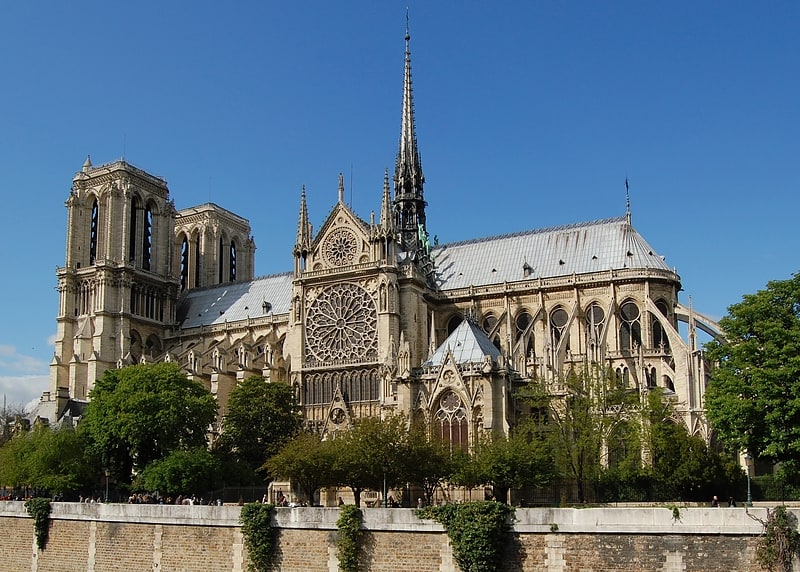
Iconic Gothic church with literary link. Notre-Dame de Paris, referred to simply as Notre-Dame, is a medieval Catholic cathedral on the Île de la Cité, in the 4th arrondissement of Paris. The cathedral, dedicated to the Virgin Mary, is considered one of the finest examples of French Gothic architecture. Several of its attributes set it apart from the earlier Romanesque style, particularly its pioneering use of the rib vault and flying buttress, its enormous and colourful rose windows, and the naturalism and abundance of its sculptural decoration. Notre Dame also stands out for its musical components, notably its three pipe organs and its immense church bells.
Construction of the cathedral began in 1163 under Bishop Maurice de Sully and was largely completed by 1260, though it was modified frequently in the centuries that followed. In the 1790s, during the French Revolution, Notre-Dame suffered extensive desecration; much of its religious imagery was damaged or destroyed. In the 19th century, the coronation of Napoleon I and the funerals of many of the French Republic's presidents took place at the cathedral.
The 1831 publication of Victor Hugo's novel Notre-Dame de Paris (known in English as The Hunchback of Notre-Dame) inspired popular interest in the cathedral, which led to a major restoration project between 1844 and 1864, supervised by Eugène Viollet-le-Duc. During World War II, after the Allies' 1944 victory in Europe, the liberation of Paris was celebrated in Notre-Dame with the singing of the Magnificat. Beginning in 1963, the cathedral's façade was cleaned of centuries of soot and grime. Another cleaning and restoration project was carried out between 1991 and 2000.
The cathedral is one of the most widely recognized symbols of the city of Paris and the French nation. In 1805, it was awarded the honorary status of a minor basilica. As the cathedral of the archdiocese of Paris, Notre-Dame contains the cathedra of the archbishop of Paris (Michel Aupetit).
Approximately 12 million people visit Notre-Dame annually, making it the most visited monument in Paris. The cathedral has long been renowned for its Lent sermons, a tradition founded in the 1830s by the Dominican Jean-Baptiste Henri Lacordaire. In recent years, these sermons have increasingly often been given by leading public figures or government-employed academics.
Over time, the cathedral has gradually been stripped of many of its original decorations and artworks. However, the cathedral still contains several noteworthy examples of Gothic, Baroque, and 19th-century sculptures, a number of 17th- and early 18th-century altarpieces, and some of the most important relics in Christendom – including the Crown of Thorns, a sliver of the true cross and a nail from the true cross.
On 15 April 2019, while Notre-Dame was undergoing renovation and restoration, its roof caught fire and burned for about 15 hours. The cathedral sustained serious damage as a result. The flèche (the timber spirelet over the crossing) was destroyed, as was most of the lead-covered wooden roof above the stone vaulted ceiling. This resulted in contamination of the site and the nearby environment with lead. After the fire, many of the proposals for restoration suggested modernizing the cathedral's design, but the French National Assembly rejected this approach, enacting a law on 29 July 2019 that required the restoration to preserve the cathedral's “historic, artistic and architectural interest”. The task of stabilizing the building against possible collapse was completed in November 2020, and reconstruction began in 2021. The government of France has said it hopes the reconstruction can be completed by Spring 2024, in time for the opening of the 2024 Summer Olympics in Paris. President Emmanuel Macron confirmed on 14 April 2021 that the cathedral site will be formally returned to the church on 15 April 2024, and that the first mass since the fire will be held in the cathedral nave on that day, even if the reconstruction has not been finished by then.[4]
Address: 6 Parvis Notre-Dame - Pl. Jean-Paul II, 75004 Paris (Hôtel-de-Ville)
Arc de Triomphe
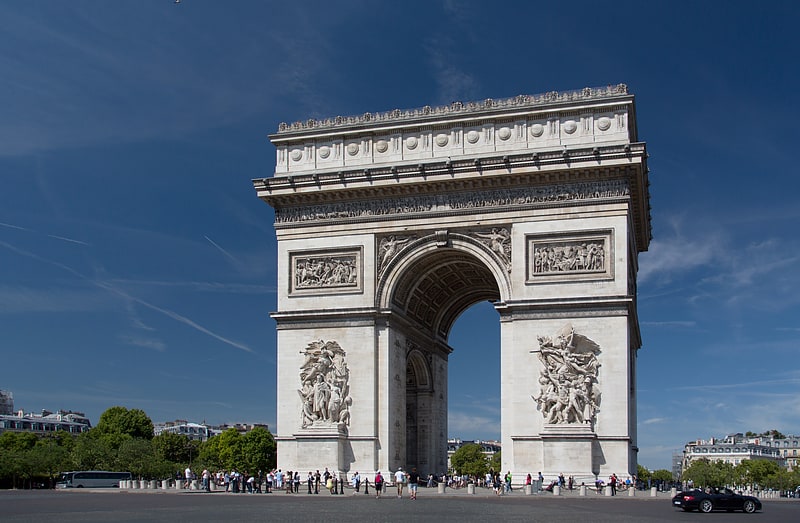
Also known as: Arc de triomphe de l'Étoile
Monument in Paris, France. The Arc de Triomphe de l'Étoile is one of the most famous monuments in Paris, France, standing at the western end of the Champs-Élysées at the centre of Place Charles de Gaulle, formerly named Place de l'Étoile—the étoile or "star" of the juncture formed by its twelve radiating avenues. The location of the arc and the plaza is shared between three arrondissements, 16th, 17th, and 8th. The Arc de Triomphe honours those who fought and died for France in the French Revolutionary and Napoleonic Wars, with the names of all French victories and generals inscribed on its inner and outer surfaces. Beneath its vault lies the Tomb of the Unknown Soldier from World War I.
The central cohesive element of the Axe historique (historic axis, a sequence of monuments and grand thoroughfares on a route running from the courtyard of the Louvre to the Grande Arche de la Défense), the Arc de Triomphe was designed by Jean Chalgrin in 1806; its iconographic programme pits heroically nude French youths against bearded Germanic warriors in chain mail. It set the tone for public monuments with triumphant patriotic messages. Inspired by the Arch of Titus in Rome, Italy, the Arc de Triomphe has an overall height of 50 metres (164 ft), width of 45 m (148 ft) and depth of 22 m (72 ft), while its large vault is 29.19 m (95.8 ft) high and 14.62 m (48.0 ft) wide. The smaller transverse vaults are 18.68 m (61.3 ft) high and 8.44 m (27.7 ft) wide. Three weeks after the Paris victory parade in 1919 (marking the end of hostilities in World War I), Charles Godefroy flew his Nieuport biplane under the arch's primary vault, with the event captured on newsreel.
Paris's Arc de Triomphe was the tallest triumphal arch until the completion of the Monumento a la Revolución in Mexico City in 1938, which is 67 metres (220 ft) high. The Arch of Triumph in Pyongyang, completed in 1982, is modelled on the Arc de Triomphe and is slightly taller at 60 m (197 ft). La Grande Arche in La Défense near Paris is 110 metres high. Although it is not named an Arc de Triomphe, it has been designed on the same model and in the perspective of the Arc de Triomphe. It qualifies as the world's tallest arch.[5]
Address: Place Charles de Gaulle, 75008 Paris (Passy)
Jardin du Luxembourg
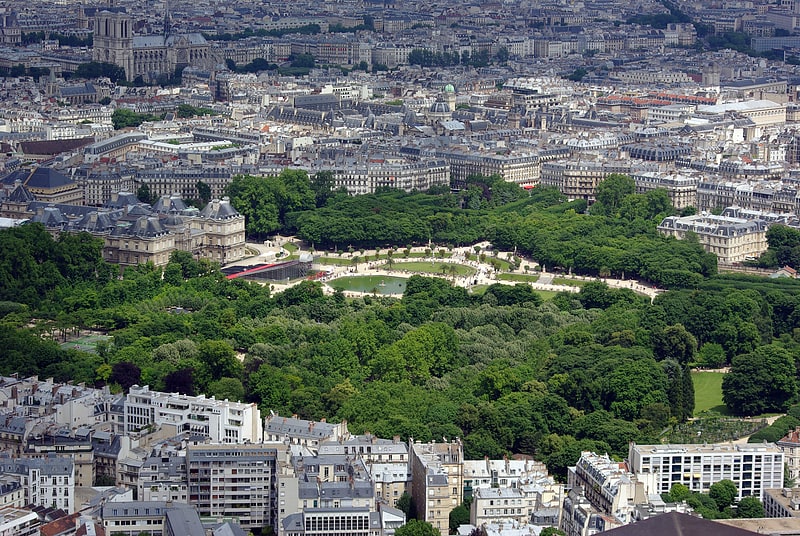
Park with manicured lawns and statues. The Jardin du Luxembourg, known in English as the Luxembourg Garden, colloquially referred to as the Jardin du Sénat, is located in the 6th arrondissement of Paris, France. Creation of the garden began in 1612 when Marie de' Medici, the widow of King Henry IV, constructed the Luxembourg Palace as her new residence. The garden today is owned by the French Senate, which meets in the Palace. It covers 23 hectares and is known for its lawns, tree-lined promenades, tennis courts, flowerbeds, model sailboats on its octagonal Grand Bassin, as well as picturesque Medici Fountain, built in 1620. The name Luxembourg comes from the Latin Mons Lucotitius, the name of the hill where the garden is located.[6]
Address: Rue de Vaugirard, Boulevard St. Michel, Rue Auguste-Comte and Rue Guynemer, 75006 Paris (Luxembourg)
Musée du quai Branly - Jacques Chirac
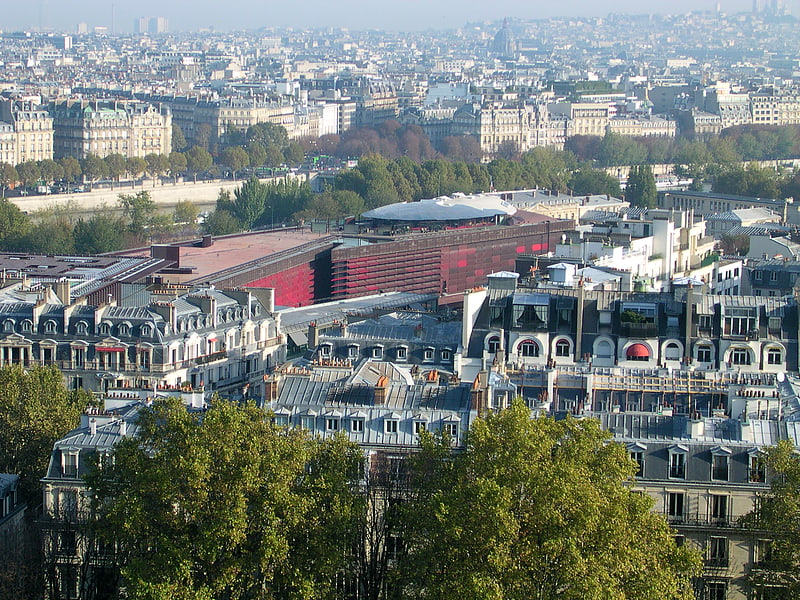
Also known as: Musée du quai Branly - Jacques-Chirac
Global collection of tribal artifacts. The Musée du quai Branly – Jacques Chirac, located in Paris, France, is a museum designed by French architect Jean Nouvel to feature the indigenous art and cultures of Africa, Asia, Oceania, and the Americas. The museum collection comprises more than a million objects, of which 3,500 are on display at any given time, in both permanent and temporary thematic exhibits. A selection of objects from the museum are also displayed in the Pavillon des Sessions of the Louvre.
The Quai Branly Museum opened in 2006, and is the newest of the major museums in Paris and received 1.15 million visitors in 2016. It is jointly administered by the French Ministry of Culture and Communication and the Ministry of Higher Education and Research, and serves as both a museum and as a center for research. The Musée du quai Branly is located in the 7th arrondissement of Paris, on the left bank of the Seine, close to the Eiffel Tower and the Pont de l'Alma.
The museum has been the subject of controversy, with some calling for the repatriation of its collections that were acquired through colonial conquest.[7]
Address: 37 Quai Branly, 75007 Paris (Palais-Bourbon)
Champ de Mars
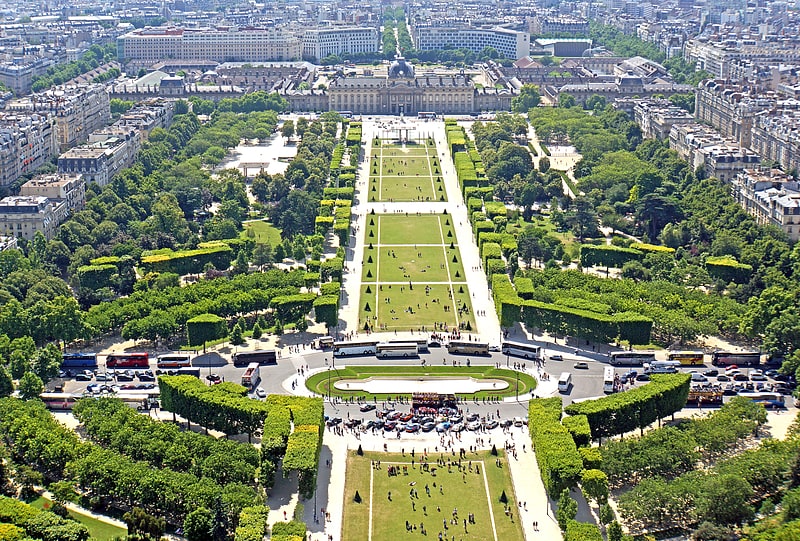
Also known as: Champ-de-Mars
Landscaped park with extensive lawns. The Champ de Mars is a large public greenspace in Paris, France, located in the seventh arrondissement, between the Eiffel Tower to the northwest and the École Militaire to the southeast. The park is named after the Campus Martius in Rome, a tribute to the Roman god of war. The name alludes to the fact that the lawns here were formerly used as drilling and marching grounds by the French military.
The nearest Métro stations are La Motte-Picquet–Grenelle, École Militaire, and Champ de Mars-Tour Eiffel, an RER suburban-commuter-railway station. A disused station, Champ de Mars, is also nearby.[8]
Sacré-Cœur

Landmark hilltop white basilica. The Basilica of the Sacred Heart of Paris, commonly known as Sacré-Cœur Basilica and often simply Sacré-Cœur, is a Roman Catholic church and minor basilica in Paris, France, dedicated to the Sacred Heart of Jesus.
Sacré-Cœur Basilica is located at the summit of the butte Montmartre, the highest point in the city. It is a popular landmark, and the second-most visited monument in Paris. Sacré-Cœur Basilica has maintained a perpetual adoration of the Holy Eucharist since 1885. The basilica was designed by Paul Abadie. Construction began in 1875 and was completed in 1914. The basilica was consecrated after the end of World War I in 1919.
It is considered as both a political and cultural monument, representing a national penance for the defeat of France in the 1870 Franco-Prussian War and for the actions of the Paris Commune of 1871. The church was constructed close to the site of the beginning of the Paris Commune where, on March 18, 1871. Communard soldiers killed two French army generals and seized a park full of artillery. There was (and remains) a feeling of resentment on the French left that the massacre of the Communards was commemorated by a temple of a fundamentally conservative religion. So great was the dislike of Sacré-Cœur at the fin de siècle that the Montmartre group of artists, including van Gogh, Matisse, Degas and Toulouse-Lautrec, decamped en masse to Montparnasse.[9]
Address: 35 Rue du Chevalier de la Barre, 75018 Paris (Buttes-Montmartre)
Musée d'Orsay
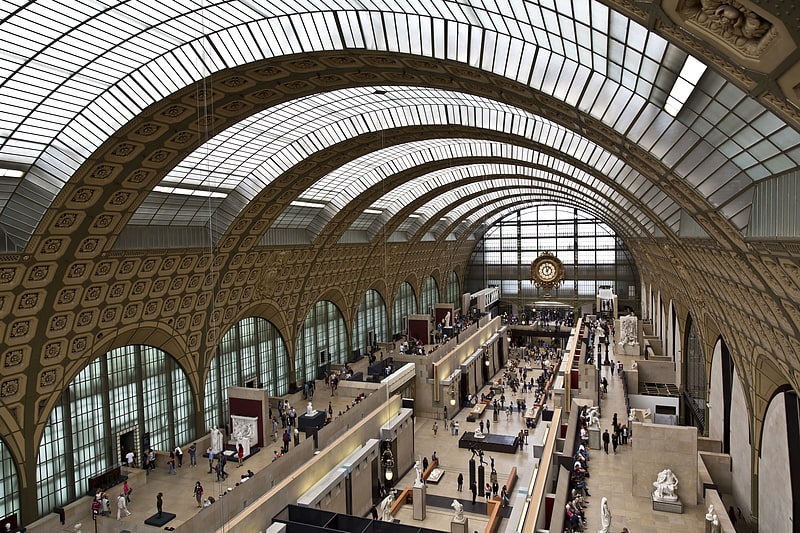
Masterpieces of 19th- and 20th-century art. The Musée d'Orsay is a museum in Paris, France, on the Left Bank of the Seine. It is housed in the former Gare d'Orsay, a Beaux-Arts railway station built between 1898 and 1900. The museum holds mainly French art dating from 1848 to 1914, including paintings, sculptures, furniture, and photography. It houses the largest collection of Impressionist and post-Impressionist masterpieces in the world, by painters including Berthe Morisot, Monet, Manet, Degas, Renoir, Cézanne, Seurat, Sisley, Gauguin, and Van Gogh. Many of these works were held at the Galerie nationale du Jeu de Paume prior to the museum's opening in 1986. It is one of the largest art museums in Europe.
In 2021 the museum had one million visitors, up 30 percent from attendance in 2020, but far behind earlier years, due to the COVID-19 pandemic. Despite the drop, it ranked fifteenth in the list of most-visited art museums in 2020.[10]
Address: 1 Rue de la Légion d'Honneur, 75007 Paris (Palais-Bourbon)
Palais Garnier
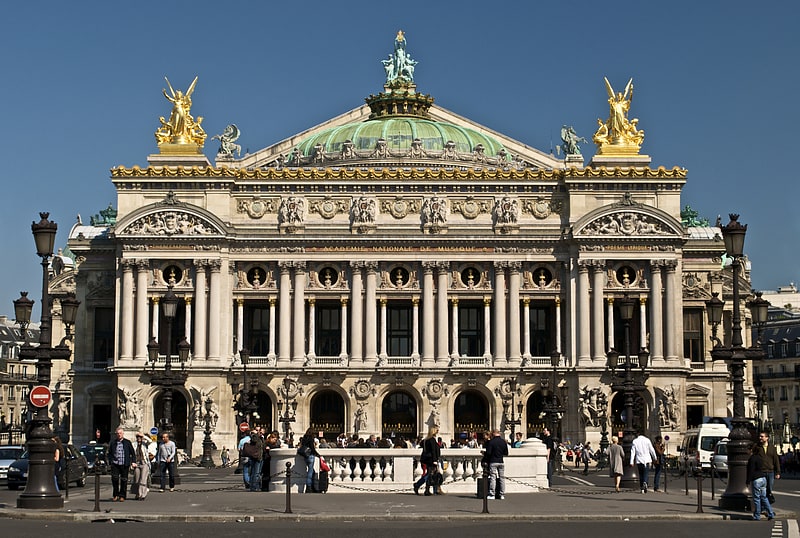
Also known as: Opéra Garnier
Italian-style opera with Library Museum. The Palais Garnier, also known as Opéra Garnier, is a 1,979-seat opera house at the Place de l'Opéra in the 9th arrondissement of Paris, France. It was built for the Paris Opera from 1861 to 1875 at the behest of Emperor Napoleon III. Initially referred to as le nouvel Opéra de Paris, it soon became known as the Palais Garnier, "in acknowledgment of its extraordinary opulence" and the architect Charles Garnier's plans and designs, which are representative of the Napoleon III style. It was the primary theatre of the Paris Opera and its associated Paris Opera Ballet until 1989, when a new opera house, the Opéra Bastille, opened at the Place de la Bastille. The company now uses the Palais Garnier mainly for ballet. The theatre has been a monument historique of France since 1923.
The Palais Garnier has been called "probably the most famous opera house in the world, a symbol of Paris like Notre Dame Cathedral, the Louvre, or the Sacré Coeur Basilica." This is at least partly due to its use as the setting for Gaston Leroux's 1910 novel The Phantom of the Opera and, especially, the novel's subsequent adaptations in films and the popular 1986 musical. Another contributing factor is that among the buildings constructed in Paris during the Second Empire, besides being the most expensive, it has been described as the only one that is "unquestionably a masterpiece of the first rank." This opinion is far from unanimous however: the 20th-century French architect Le Corbusier once described it as "a lying art" and contended that the "Garnier movement is a décor of the grave".
The Palais Garnier also houses the Bibliothèque-Musée de l'Opéra de Paris (Paris Opera Library-Museum), which is managed by the Bibliothèque Nationale de France and is included in unaccompanied tours of the Palais Garnier.[11]
Address: Paris, Place de l'Opéra
Sainte-Chapelle
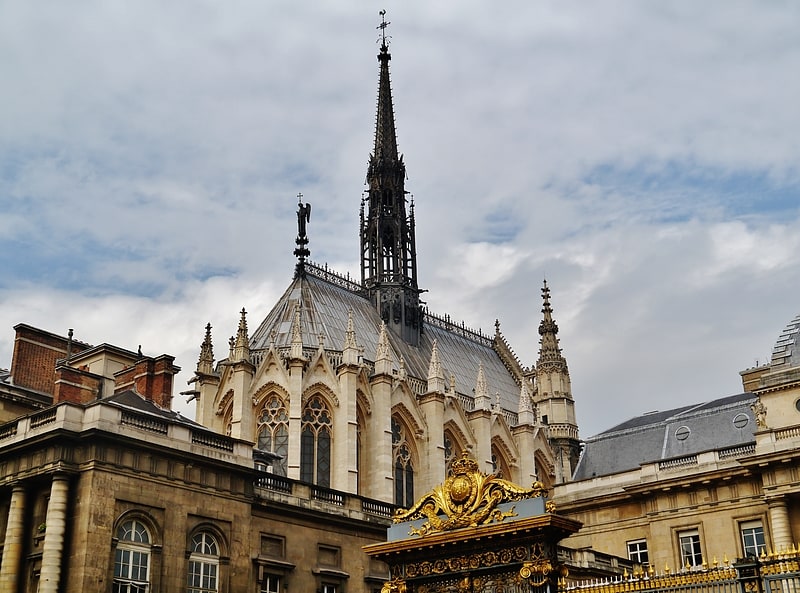
Gothic chapel with stained-glass windows. The Sainte-Chapelle is a royal chapel in the Gothic style, within the medieval Palais de la Cité, the residence of the Kings of France until the 14th century, on the Île de la Cité in the River Seine in Paris, France.
Construction began sometime after 1238 and the chapel was consecrated on 26 April 1248. The Sainte-Chapelle is considered among the highest achievements of the Rayonnant period of Gothic architecture. It was commissioned by King Louis IX of France to house his collection of Passion relics, including Christ's Crown of Thorns – one of the most important relics in medieval Christendom, later hosted in the nearby Notre-Dame Cathedral until the 2019 fire, which it survived.
Along with the Conciergerie, the Sainte-Chapelle is one of the earliest surviving buildings of the Capetian royal palace on the Île de la Cité. Although damaged during the French Revolution and restored in the 19th century, it has one of the most extensive 13th-century stained glass collections anywhere in the world.
The Sainte-Chapelle is no longer a church. It was secularised after the French Revolution, and is now operated by the French Centre of National Monuments, along with the nearby Conciergerie, the other remaining vestige of the original palace.[12]
Address: 8 Boulevard du Palais, 75001 Paris (Louvre)
Élysée Palace
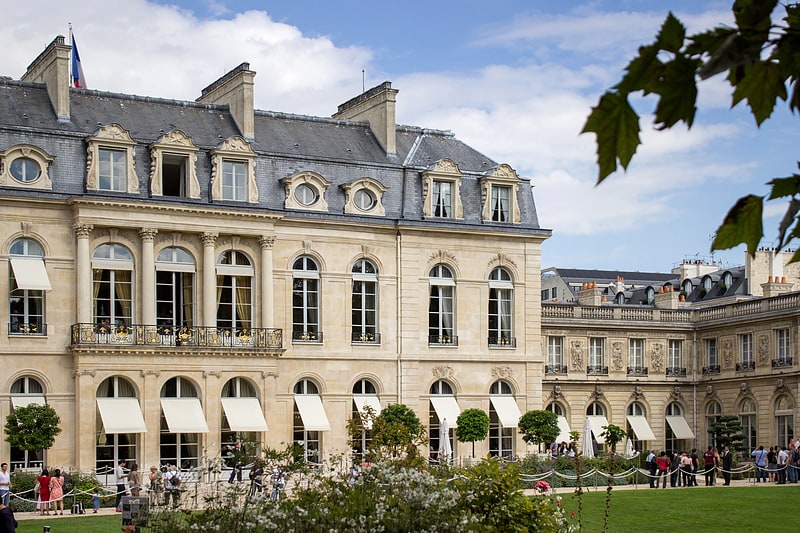
Also known as: Palais de l'Élysée
Official residence in Paris, France. The Élysée Palace is the official residence of the President of the French Republic. Completed in 1722, it was built for nobleman and army officer Louis Henri de La Tour d'Auvergne, who had been appointed Governor of Île-de-France in 1719. It is located on the Rue du Faubourg Saint-Honoré near the Champs-Élysées in the 8th arrondissement of Paris, the name Élysée deriving from the Elysian Fields, the place of the blessed dead in Greek mythology. Important foreign visitors are hosted at the nearby Hôtel de Marigny, a palatial residence.
The palace has been the home of personalities such as Madame de Pompadour (1721–1764), Nicolas Beaujon (1718–1786), Bathilde d'Orléans (1750–1822), Joachim Murat (1767–1815) and Charles Ferdinand, Duke of Berry (1778–1820). On 12 December 1848 under the Second Republic the French Parliament passed a law declaring the building the official residence of the President of France. The Élysée Palace, which contains the presidential office and residency, is also the meeting place of the Council of Ministers, the weekly meeting of the Government of France presided over by the President of the Republic.[13]
Address: Paris, 55, Rue du Faubourg Saint-Honoré, 75008 Paris, France
Palais Bourbon
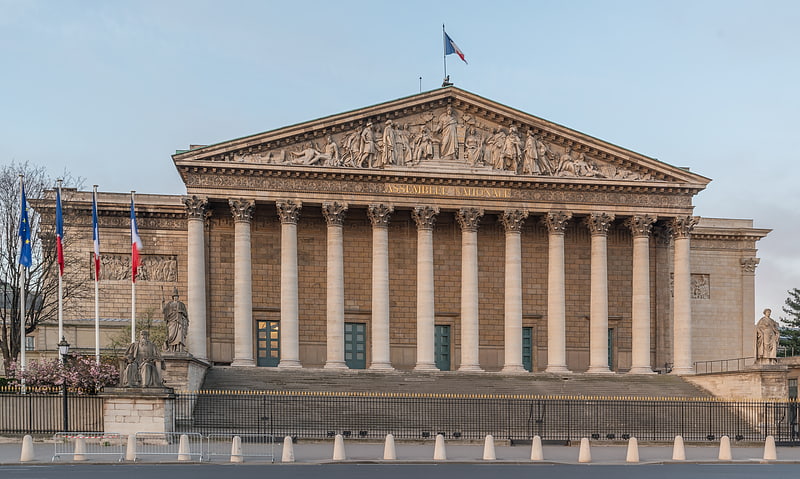
Palace in Paris, France. The Palais Bourbon is the meeting place of the National Assembly, the lower legislative chamber of the French Parliament. It is located in the 7th arrondissement of Paris, on the Rive Gauche of the Seine, across from the Place de la Concorde.
The original palace was built beginning in 1722 for Louise Françoise de Bourbon, Duchess of Bourbon, the legitimised daughter of Louis XIV and the Marquise de Montespan. Four successive architects – Lorenzo Giardini, Pierre Cailleteau, Jean Aubert and Jacques Gabriel – completed the palace in 1728. It was then nationalised during the French Revolution. From 1795 to 1799, during the Directory, it was the meeting place of the Council of Five Hundred, which chose the government leaders. Beginning in 1806, during Napoleon's French Empire, Bernard Poyet's Neoclassical facade was added to mirror that of the Church of the Madeleine, facing it across the Seine beyond the Place de la Concorde.
The palace complex today has a floor area of 124,000 m2 (1,330,000 sq ft), with over 9,500 rooms, in which 3,000 people work. The complex includes the Hôtel de Lassay, on the west side of the Palais Bourbon; it is the official residence of the President of the National Assembly.[14]
Address: Paris, 126 Rue de l'Université
Louvre Palace

Also known as: Palais du Louvre
Palace. The Louvre Palace, often referred to simply as the Louvre, is an iconic building of the French state located on the Right Bank of the Seine in Paris, occupying a vast expanse of land between the Tuileries Gardens and the church of Saint-Germain l'Auxerrois. Originally a military facility, it has served numerous government-related functions in the past, including intermittently as a royal residence between the 14th and 18th centuries. It is now mostly used by the Louvre Museum, which first opened there in 1793.
Whereas the area had been inhabited for thousands of years, the Louvre's history starts around 1190 with its first construction as a fortress defending the western front of the Wall of Philip II Augustus. The Louvre's oldest section still standing above ground, its Lescot Wing, dates from the late 1540s, when Francis I started the replacement of the medieval castle with a new design inspired by classical antiquity and Italian Renaissance architecture. Most parts of the current building were constructed in the 17th and 19th centuries.
For more than three centuries, the history of the Louvre has been closely intertwined with that of the Tuileries Palace, created to its west by Catherine de' Medici in 1564 and finally demolished in 1883. The Tuileries was the main seat of French executive power during the last third of that period, from the return of the King and his court from Versailles in October 1789 to the Paris Commune which decided to burn it down in its final days in May 1871. The Pavillon de Flore and Pavillon de Marsan, which used to respectively mark the southern and northern ends of the Tuileries, are now considered part of the Louvre Palace. The Carrousel Garden, first created in the late 19th century in what used to be the great courtyard of the Tuileries (or Cour du Carrousel), is now considered part of the Tuileries Garden. A less high-profile but historically significant dependency of the Louvre was to its immediate east, the Hôtel du Petit-Bourbon, appropriated by the monarchy following the betrayal of the Constable of Bourbon in 1523 and mostly demolished in October 1660 to give way to the Louvre's expansion. The last remains of the Petit-Bourbon were cleared in the 1760s.[15]
Address: Quai Francois Mitterrand, 75001 Paris (Louvre)
Grand Palais

1900 exhibition hall with glass roof. The Grand Palais des Champs-Élysées, commonly known as the Grand Palais, is a historic site, exhibition hall and museum complex located at the Champs-Élysées in the 8th arrondissement of Paris, France. Construction of the Grand Palais began in 1897 following the demolition of the Palais de l'Industrie to prepare for the Universal Exposition of 1900. That exposition also produced the adjacent Petit Palais and Pont Alexandre III.
The building was designed to be a large-scale venue for official artistic events. A pediment on the building refers to this function with an inscription that reads, "a monument dedicated by the Republic to the glory of French art." Designed according to Beaux-Arts tastes, the building features ornate stone facades, glass vaults and period innovations that included iron and light steel framing and reinforced concrete.
It is listed as a historic monument by the Ministry of Culture.[16]
Address: 3 Avenue du Général Eisenhower, 75008 Paris (Élysée)
Jardins du Trocadéro
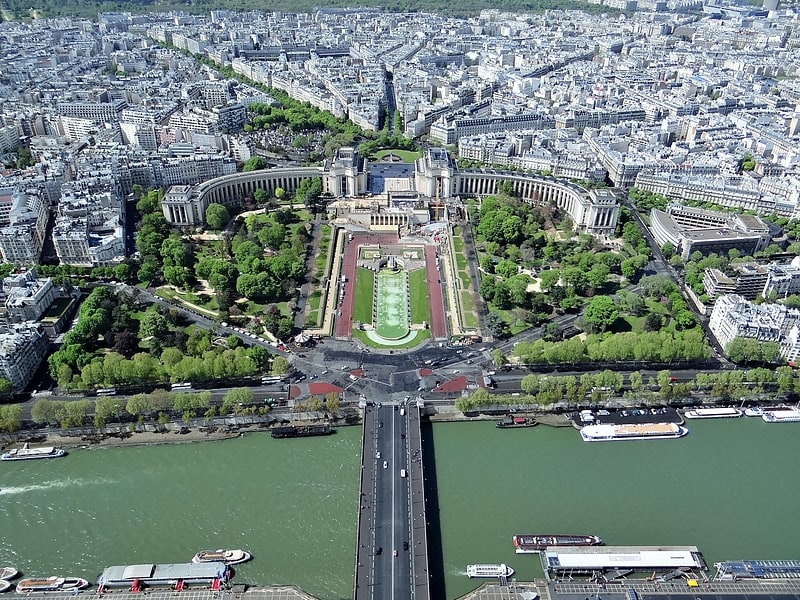
Public park with sculptures and a fountain. Jardins du Trocadéro is an open space in Paris, located in the 16th arrondissement of Paris, bounded to the northwest by the wings of the Palais de Chaillot and to the southeast by the Seine and the Pont d'Iéna, with the Eiffel Tower on the opposite bank of the Seine.
The main feature, called the Fountain of Warsaw, is a long basin, or water mirror, with twelve fountain creating columns of water 12 metres high; twenty four smaller fountains four metres high; and ten arches of water. At one end, facing the Seine, are twenty powerful water cannons, able to project a jet of water fifty metres. Above the long basin are two smaller basins, linked with the lower basin by cascades flanked by 32 sprays of water four meters high. These fountains are the only exposition fountains which still exist today, and still function as they once did. In 2011, the fountain's waterworks were completely renovated and a modern pumping system was installed.[17]
Address: Place du Trocadéro et du 11 Novembre, 75016 Paris (Passy)
Tuileries Garden
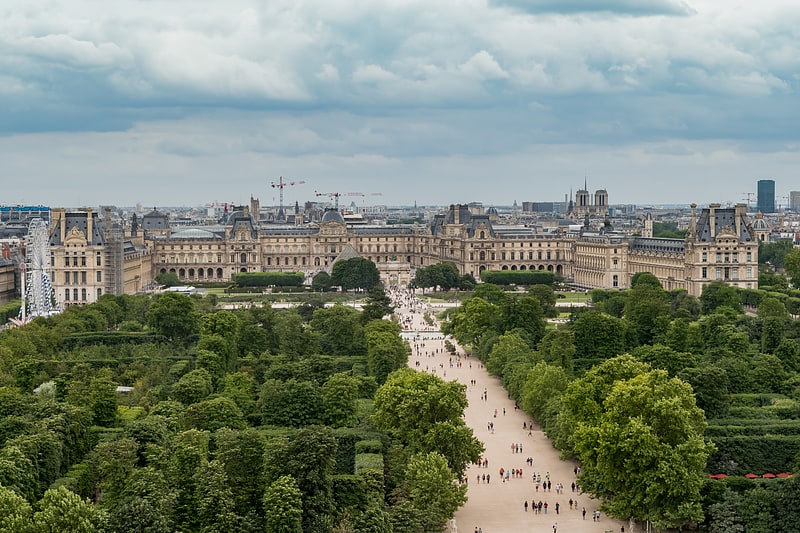
Also known as: Jardin des Tuileries
Vast statue-studded 17th-century gardens. The Tuileries Garden is a public garden located between the Louvre and the Place de la Concorde in the 1st arrondissement of Paris, France. Created by Catherine de' Medici as the garden of the Tuileries Palace in 1564, it was eventually opened to the public in 1667 and became a public park after the French Revolution. In the 19th, 20th and 21st centuries, it was a place where Parisians celebrated, met, strolled and relaxed.[18]
Address: Place de la Concorde, 75001 Paris (Louvre)
Grande Arche
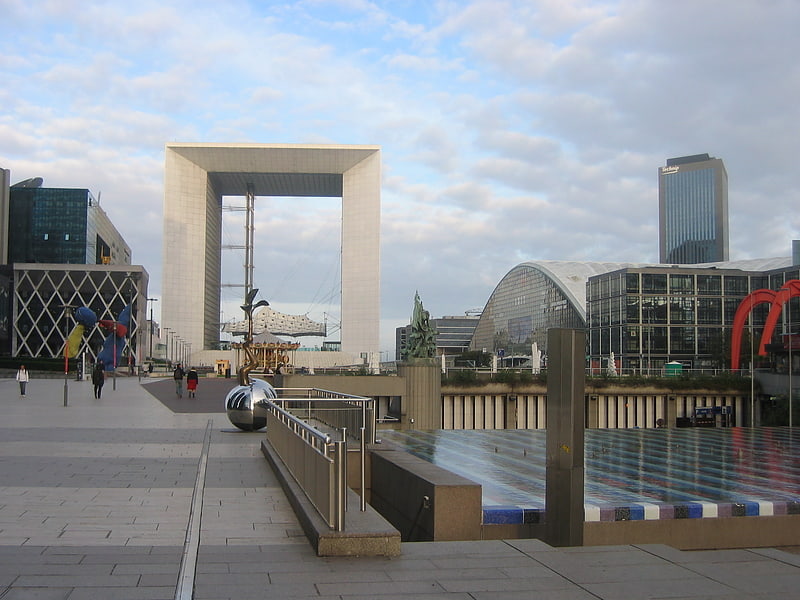
Also known as: Arche de la Défense
Cube-shaped architectural monument. La Grande Arche de la Défense, originally called La Grande Arche de la Fraternité, is a monument and building in the business district of La Défense and in the commune of Puteaux, to the west of Paris, France. It is usually known as the Arche de la Défense or simply as La Grande Arche. A 110-metre-high cube, La Grande Arche is part of the perspective from the Louvre to Arc de Triomphe, and was one of the Grands Projets of François Mitterrand. The distance from La Grande Arche to Arc de Triomphe is 4 km.[19]
Address: 1 Parvis de la Défense, 92800 Puteaux (Puteaux)
Château de Malmaison
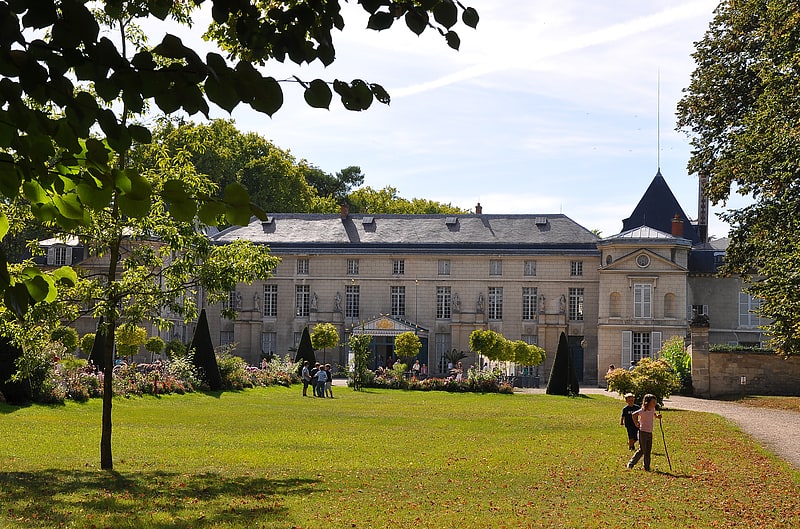
One-time home of Napoleon and Joséphine. The Château de Malmaison is a French château situated near the left bank of the Seine, about 15 kilometres west of the centre of Paris, in the municipality of Rueil-Malmaison.
Formerly the residence of Empress Joséphine de Beauharnais, along with the Tuileries it was the headquarters of the French government from 1800 to 1802, and Napoleon's last residence in France at the end of the Hundred Days in 1815.[20]
Address: Avenue du Château de la Malmaison, 92500 Rueil-Malmaison (Rueil-Malmaison)
Petit Palais
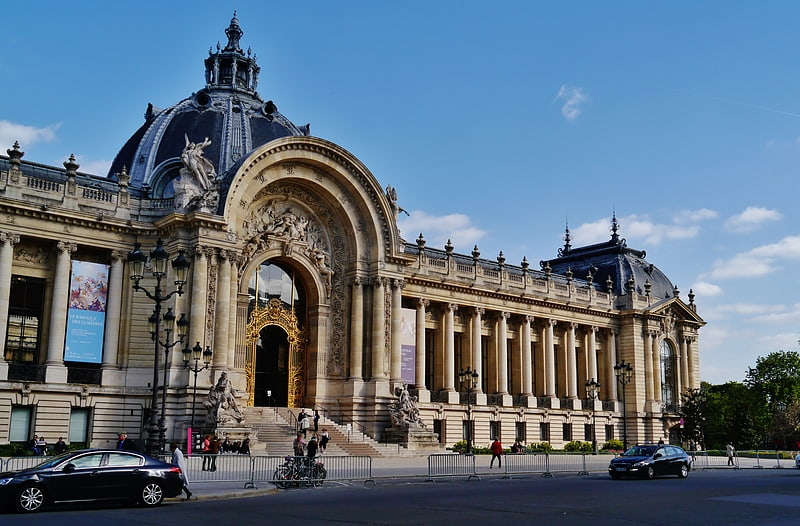
Fine arts museum in ornate building. The Petit Palais is an art museum in the 8th arrondissement of Paris, France.
Built for the 1900 Exposition Universelle ("universal exhibition"), it now houses the City of Paris Museum of Fine Arts (Musée des beaux-arts de la ville de Paris). The Petit Palais is located across from the Grand Palais on Avenue Nicolas II, today Avenue Winston-Churchill. The other façades of the building face the Seine and Avenue des Champs-Élysées.
The Petit Palais is one of 14 museums of the City of Paris that have been incorporated since January 1, 2013, in the public corporation Paris Musées. It has been listed since 1975 as a monument historique by the French Ministry of Culture.[21]
Address: Avenue Winston Churchill, 75008 Paris (Élysée)
Panthéon
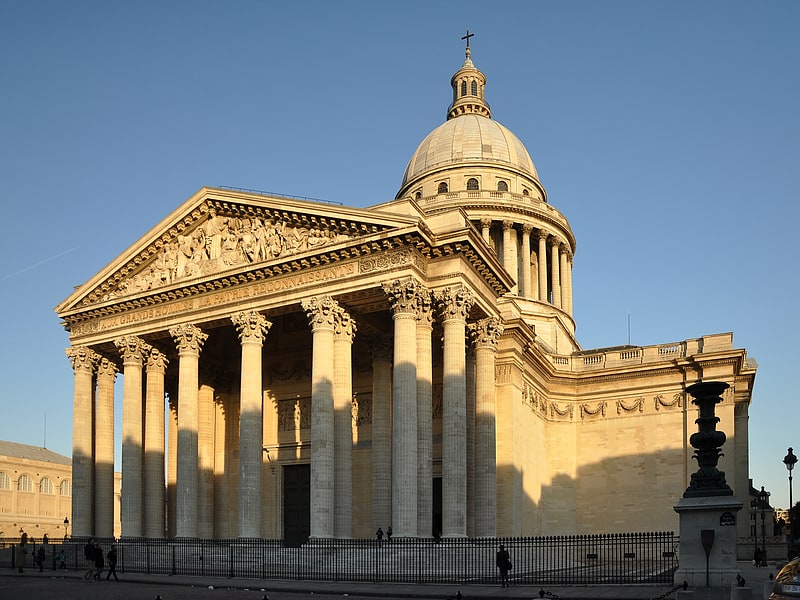
Colonnaded neoclassical mausoleum. The Panthéon is a monument in the 5th arrondissement of Paris, France. It stands in the Latin Quarter, atop the Montagne Sainte-Geneviève, in the centre of the Place du Panthéon, which was named after it. The edifice was built between 1758 and 1790, from designs by Jacques-Germain Soufflot, at the behest of King Louis XV of France; the king intended it as a church dedicated to Saint Genevieve, Paris' patron saint, whose relics were to be housed in the church. Neither Soufflot nor Louis XV lived to see the church completed.
By the time the construction was finished, the French Revolution had started; the National Constituent Assembly voted in 1791 to transform the Church of Saint Genevieve into a mausoleum for the remains of distinguished French citizens, modelled on the Pantheon in Rome which had been used in this way since the 16th century. The first panthéonisé was Honoré Gabriel Riqueti, comte de Mirabeau, although his remains were removed from the building a few years later. The Panthéon was twice restored to church usage in the course of the 19th century—although Soufflot's remains were transferred inside it in 1829—until the French Third Republic finally decreed the building's exclusive use as a mausoleum in 1881. The placement of Victor Hugo's remains in the crypt in 1885 was its first entombment in over fifty years.
The successive changes in the Panthéon's purpose resulted in modifications of the pedimental sculptures and the capping of the dome by a cross or a flag; some of the originally existing windows were blocked up with masonry in order to give the interior a darker and more funereal atmosphere, which compromised somewhat Soufflot's initial attempt at combining the lightness and brightness of the Gothic cathedral with classical principles. The architecture of the Panthéon is an early example of Neoclassicism, surmounted by a dome that owes some of its character to Bramante's Tempietto.
In 1851, Léon Foucault conducted a demonstration of diurnal motion at the Panthéon by suspending a pendulum from the ceiling, a copy of which is still visible today. As of December 2021 the remains of 81 people (75 men and six women) had been transferred to the Panthéon. More than half of all the panthéonisations were made under Napoleon's rule during the First French Empire.[22]
Address: Place du Panthéon, 75005 Paris (Panthéon)
Jardin des Plantes

Also known as: Jardin des plantes de Paris
Expansive 17th-century botanical gardens. The Jardin des plantes, also known as the Jardin des plantes de Paris when distinguished from other jardins des plantes in other cities, is the main botanical garden in France. The term Jardin des plantes is the official name in the present day, but it is in fact an elliptical form of Jardin royal des plantes médicinales, which is related to the original purpose of the garden back in the 17th century.
Headquarters of the Muséum national d'histoire naturelle (National Museum of Natural History), the Jardin des plantes is situated in the 5th arrondissement, Paris, on the left bank of the river Seine, and covers 28 hectares (280,000 m2). Since 24 March 1993, the entire garden and its contained buildings, archives, libraries, greenhouses, ménagerie (a zoo), works of art, and specimens' collection are classified as a national historical landmark in France (labelled monument historique).[23]
Address: 57 rue Cuvier, 75005 Paris (Panthéon)
Musée de Cluny
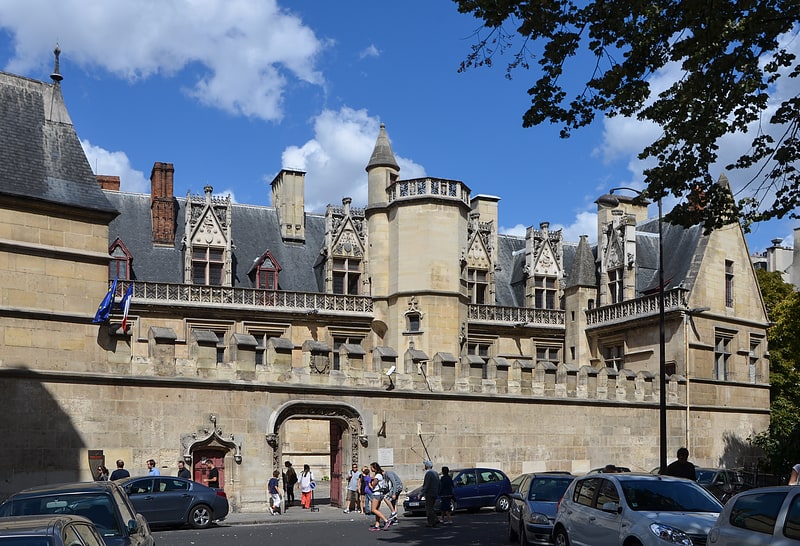
Medieval art museum in Gothic mansion. The Musée de Cluny, also known as Musée national du Moyen Âge – Thermes et hôtel de Cluny, is a museum of the Middle Ages in Paris, France. It is located in the Latin quarter in the 5th arrondissement of Paris at 6 Place Paul-Painlevé, next to the square Samuel-Paty, south of the Boulevard Saint-Germain, between the Boulevard Saint-Michel and the Rue Saint-Jacques.
The Hôtel de Cluny is partially constructed on the remnants of the third century Gallo-Roman baths known as the Thermes de Cluny, thermal baths from the Roman era of Gaul. The museum consists of two buildings: the frigidarium ("cooling room"), within the vestiges of the Thermes de Cluny, and the Hôtel de Cluny itself, which houses its collections. The frigidarium is about 6,000 square meters.
The museum houses a vast collection of objects and art from the Middle Ages. Among the principal holdings of the museum are the six tapestries of The Lady and the Unicorn (La Dame à la licorne).[24]
Address: 28 Rue du Sommerard, 75005 Paris (Panthéon)
Musée d'Art Moderne de la Ville de Paris
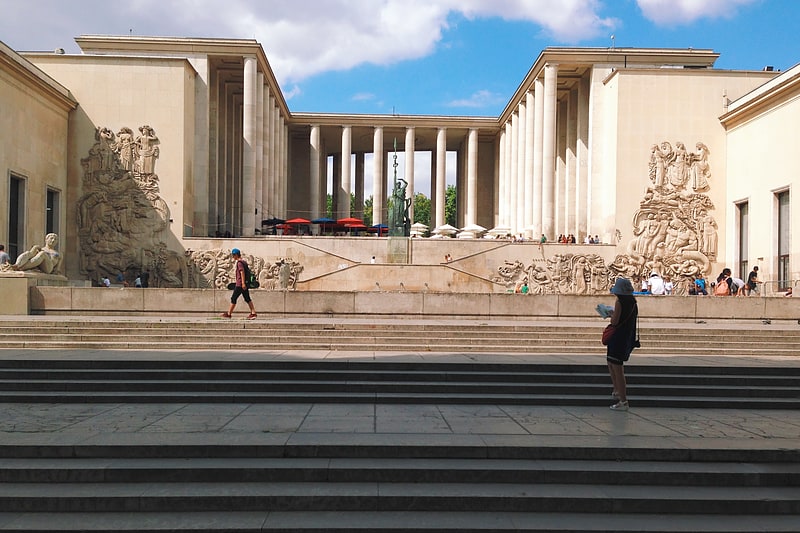
Also known as: Musée d'Art moderne de la ville de Paris
Museum in Paris, France. Musée d'Art Moderne de Paris or MAM Paris, is a major municipal museum dedicated to modern and contemporary art of the 20th and 21st centuries, including monumental murals by Raoul Dufy, Gaston Suisse, and Henri Matisse. It is located at 11, Avenue du Président Wilson in the 16th arrondissement of Paris.
The museum is one of the 14 City of Paris' Museums that have been incorporated since 1 January 2013 in the public institution Paris Musées.[25]
Address: 11 Avenue du Président Wilson, 75116 Paris (Passy)
Le Marais
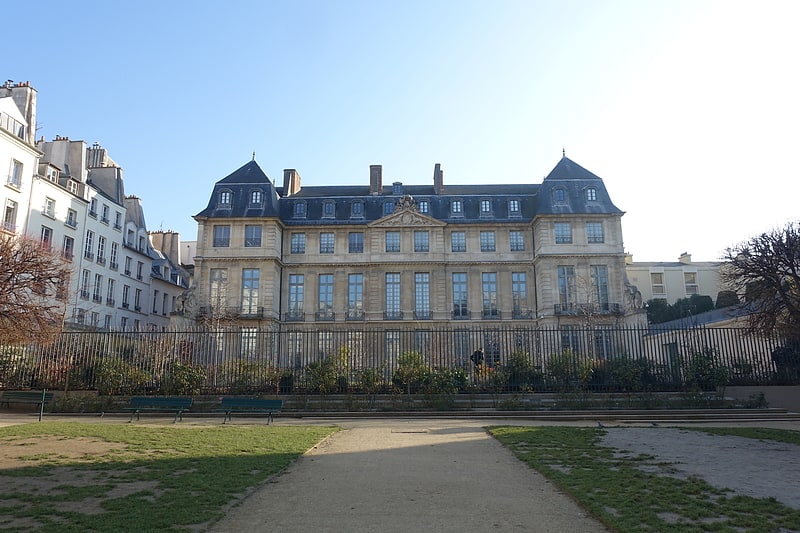
Hip boutiques and posh Place des Vosges. The Marais is a historic district in Paris, France. Long the aristocratic district of Paris, it hosts many outstanding buildings of historic and architectural importance. It spreads across parts of the 3rd and 4th arrondissements in Paris. Once shabby, the district has been rehabilitated and now sports trendy shopping and restaurants in streets such as Rue des Francs-Bourgeois and Rue des Rosiers.[26]
Musée des Arts et Métiers
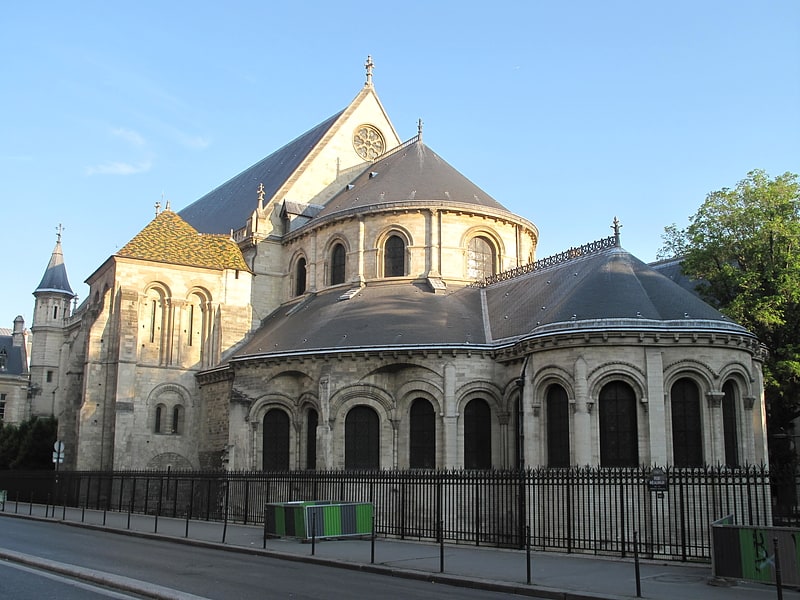
Also known as: Musée des arts et métiers
Museum in Paris, France. The Musée des Arts et Métiers is an industrial design museum in Paris that houses the collection of the Conservatoire national des arts et métiers, which was founded in 1794 as a repository for the preservation of scientific instruments and inventions.[27]
Address: 60 Rue Réaumur, 75003 Paris (Temple)
Musée National d'Art Moderne
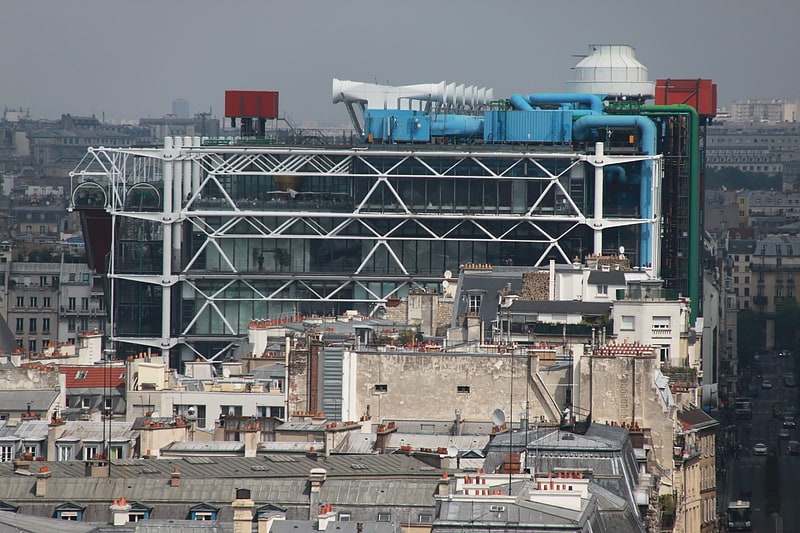
Also known as: Musée national d'Art moderne
Museum in Paris. The Musée National d'Art Moderne is the national museum for modern art of France. It is located in Paris and is housed in the Centre Pompidou in the 4th arrondissement of the city. In 2021 it ranked 10th in the List of most visited art museums in the world, with 1,501,040 visitors. It is one of the largest museums for modern and contemporary art.
In 1937, the Musée National d'Art Moderne succeeded the Musée du Luxembourg, established in 1818 by King Louis XVIII as the first museum of contemporary art created in Europe, devoted to living artists whose work was due to join the Louvre 10 years after their death. Imagined as early as 1929 by Auguste Perret to replace the old Palais du Trocadero, the construction of a museum of modern art was officially decided in 1934 in the western wing of the Palais de Tokyo. Completed in 1937 for that year's International Exhibition of Arts and Technology, it was temporarily used for another purpose, since the exhibition of national and foreign art indépendant was then preferably held in the Petit Palais and the Musée du Jeu de Paume. Although due to open in 1939, construction was eventually interrupted by the war; following the nomination of its first Chief Conservator in September 1940, the museum partially opened in 1942 with only a third of the collection brought back from some national collection caches hidden in the province. But its real inauguration didn't take place until 1947, after World War II and the addition of the foreign schools collection of the Musée du Luxembourg, which had been held at the Musée du Jeu de Paume since 1922.
In 1947, then housed in the Palais de Tokyo, its collection was dramatically increased by its first director, Jean Cassou, thanks to his special relationship with many prominent artists or their families, such as Picasso and Braque. With the creation of the Centre Pompidou, the museum moved to its current location in 1977.
The museum has the second largest collection of modern and contemporary art in the world, after the Museum of Modern Art in New York, with more than 100,000 works of art by 6,400 artists from 90 countries since Fauvism in 1905. These works include painting, sculpture, drawing, print, photography, cinema, new media, architecture, and design. A part of the collection is exhibited every two years alternately in an 18,500-square-metre (199,000 sq ft) space divided between two floors, one for modern art (from 1905 to 1960, on the 5th floor), the other for contemporary art (from 1960, on the 4th floor), and 5 exhibition halls, on a total of 28,000 m2 (300,000 sq ft) within the Centre Pompidou. The Atelier Brancusi is located in its own building adjacent to the museum.
The works displayed in the museum often change in order to show to the public the variety and depth of the collection. Many major temporary exhibitions of modern and contemporary art have taken place on a separate floor (the 6th) over the years, among them many one-person exhibitions. Since 2010, the museum has also displayed unique, temporary exhibitions in its provincial branch, the Centre Pompidou-Metz, in a 10,000-square-metre (110,000 sq ft) space divided between 3 galleries and since 2015, in Málaga, Spain, and 2018, in Brussels, Belgium.[28]
Les Invalides
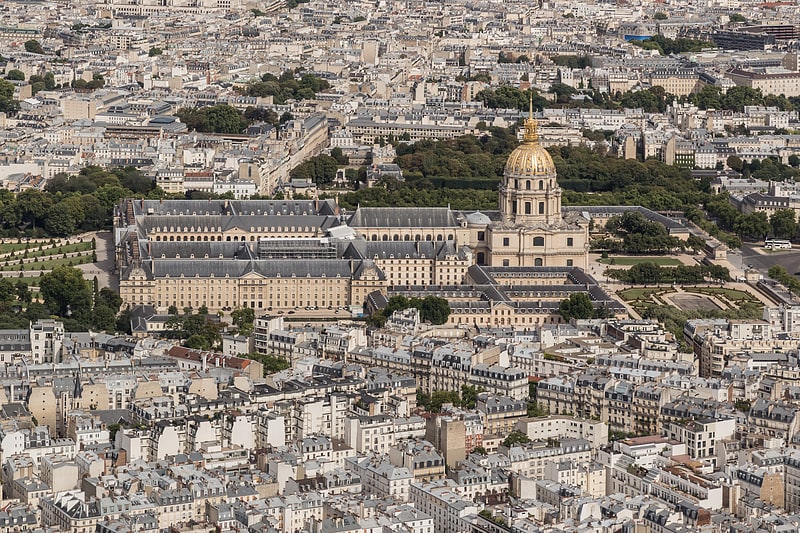
Also known as: Hôtel des Invalides
Military museums and interred war heroes. Les Invalides, formally the Hôtel national des Invalides, also Hôtel des Invalides is a complex of buildings in the 7th arrondissement of Paris, France, containing museums and monuments, all relating to the military history of France, as well as a hospital and a retirement home for war veterans, the buildings’ original purpose. The buildings house the Musée de l'Armée, the military museum of the Army of France, the Musée des Plans-Reliefs, and the Musée d'Histoire Contemporaine. The complex also includes the former hospital chapel, now national cathedral of the French military, and the adjacent former Royal Chapel known as the Dôme des Invalides, the tallest church building in Paris at a height of 107 meters. The latter has been converted into a shrine of some of France's leading military figures, most notably the tomb of Napoleon.[29]
Address: Rond-Point du Bleuet de France, 75007 Paris (Palais-Bourbon)
Musée Guimet
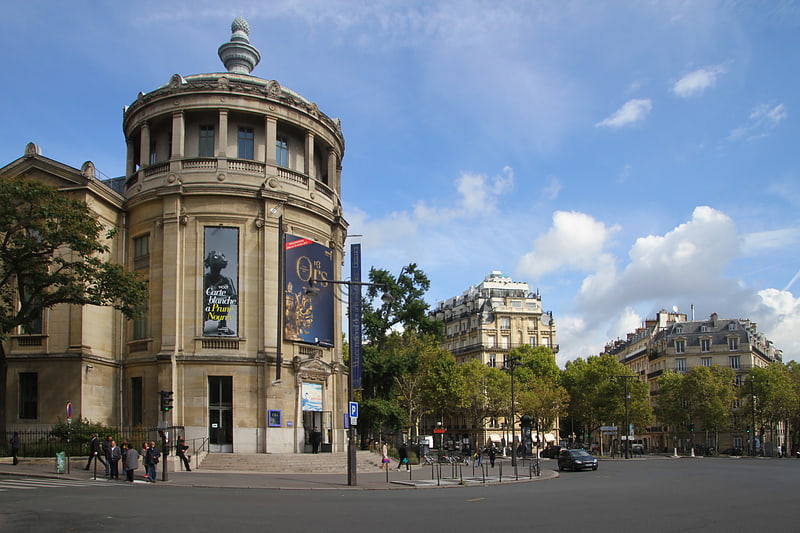
Also known as: Musée national des arts asiatiques - Guimet
Museum in Paris, France. The Guimet Museum, abbr. Musée Guimet, is an art museum located at 6, place d'Iéna in the 16th arrondissement of Paris, France. Literally translated into English, its full name is the National Museum of Asian Arts-Guimet, or Guimet National Museum of Asian Arts.
The museum has one of the largest collections of Asian art outside of Asia.[30]
Address: 6 Place d'Iéna, 75116 Paris (Passy)
Moulin Rouge
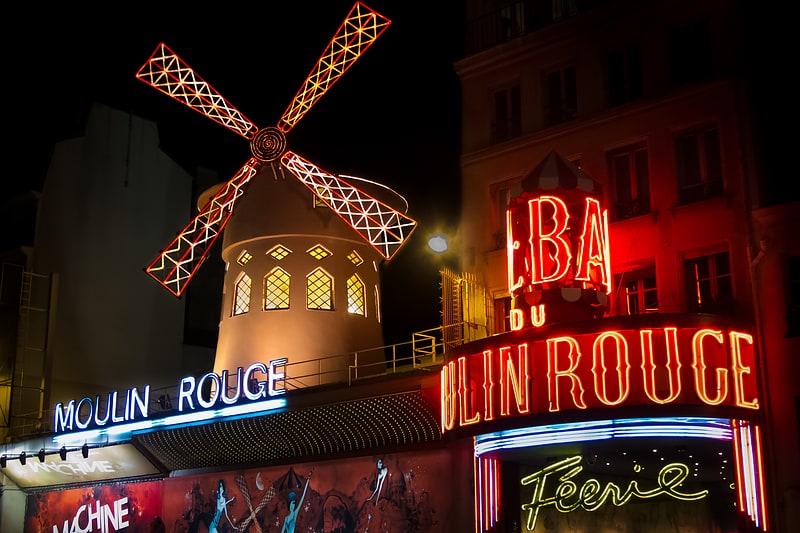
Also known as: Moulin-Rouge
Legendary Belle Epoque cabaret. Moulin Rouge is a cabaret in Paris, France.
The original house, which burned down in 1915, was co-founded in 1889 by Charles Zidler and Joseph Oller, who also owned the Paris Olympia. Close to Montmartre in the Paris district of Pigalle on Boulevard de Clichy in the 18th arrondissement, it is marked by the red windmill on its roof. The closest métro station is Blanche.
Moulin Rouge is best known as the birthplace of the modern form of the can-can dance. Originally introduced as a seductive dance by the courtesans who operated from the site, the can-can dance revue evolved into a form of entertainment of its own and led to the introduction of cabarets across Europe. Today, the Moulin Rouge is a tourist attraction, offering musical dance entertainment for visitors from around the world. The club's decor still contains much of the romance of fin de siècle France.[31]
Address: Paris, 82 Boulevard de Clichy
Musée Rodin
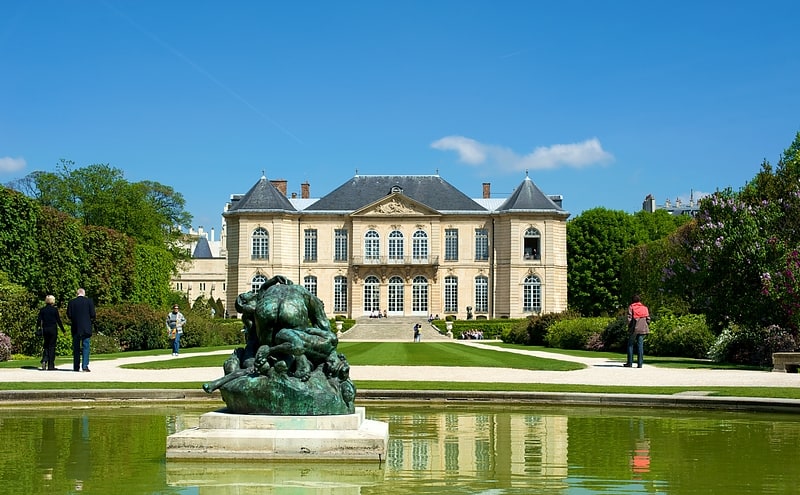
Mansion and garden with sculptor's works. The Musée Rodin in Paris, France, is a museum that was opened in 1919, primarily dedicated to the works of the French sculptor Auguste Rodin. It has two sites: the Hôtel Biron and surrounding grounds in central Paris, as well as just outside Paris at Rodin's old home, the Villa des Brillants at Meudon, Hauts-de-Seine. The collection includes 6,600 sculptures, 8,000 drawings, 8,000 old photographs and 7,000 objets d’art. The museum receives 700,000 visitors annually.
While living in the Villa des Brillants, Rodin used the Hôtel Biron as his workshop from 1908, and subsequently donated his entire collection of sculptures – along with paintings by Vincent van Gogh, Claude Monet and Pierre-Auguste Renoir that he had acquired – to the French State on the condition that they turn the buildings into a museum dedicated to his works. The Musée Rodin contains most of Rodin's significant creations, including The Thinker, The Kiss and The Gates of Hell. Many of his sculptures are displayed in the museum's extensive garden. The museum includes a room dedicated to the works of Camille Claudel and one of the two castings of The Mature Age.
The gardens around the museum building contain many of the famous sculptures in natural settings. Behind the museum building are a small lake and casual restaurant. Additionally, the nearby Métro stop, Varenne, features some of Rodin's sculptures on the platform. The building is served by Métro (Line 13), RER (Line C: Invalides) and bus (69, 82, 87, 92).[32]
Address: 77 Rue de Varennes, 75007 Paris (Palais-Bourbon)
Arc de Triomphe du Carrousel

Also known as: Arc de triomphe du Carrousel
Monument in Paris, France. The Arc de Triomphe du Carrousel is a triumphal arch in Paris, located in the Place du Carrousel. It is an example of Neoclassical architecture in the Corinthian order. It was built between 1806 and 1808 to commemorate Napoleon's military victories in the Wars of the Third and Fourth Coalitions. The Arc de Triomphe de l'Étoile, at the far end of the Champs Élysées, was designed in the same year; it is about twice the size and was not completed until 1836.[33]
Address: Place du Carrousel, 75001 Paris (Louvre)
National Museum of Natural History
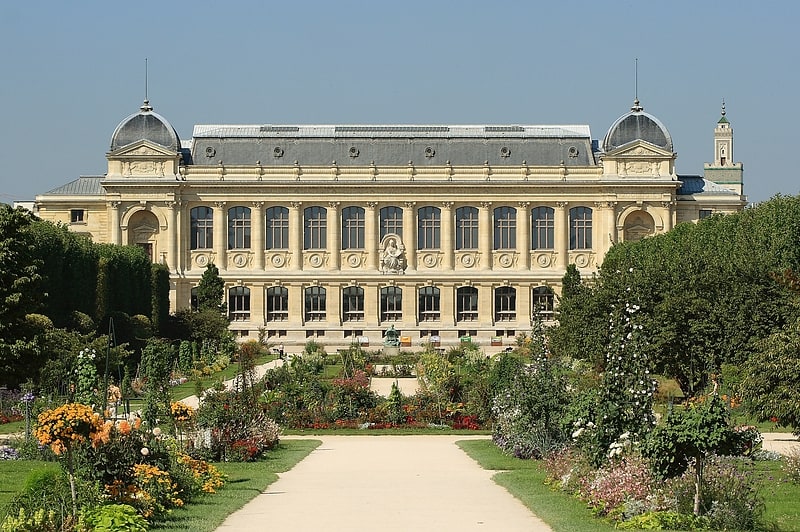
Also known as: Muséum national d'histoire naturelle
Science and nature exhibits since 1793. The French National Museum of Natural History, known in French as the Muséum national d'histoire naturelle, is the national natural history museum of France and a grand établissement of higher education part of Sorbonne Universities. The main museum, with four galleries, is located in Paris, France, within the Jardin des Plantes on the left bank of the River Seine. It was formally founded in 1793 during the French Revolution, but was begun even earlier in 1635 as the royal garden of medicinal plants. The museum now has 14 sites throughout France.[34]
Address: 57 Rue Cuvier, 75005 Paris (Panthéon)
Boulevard Haussmann
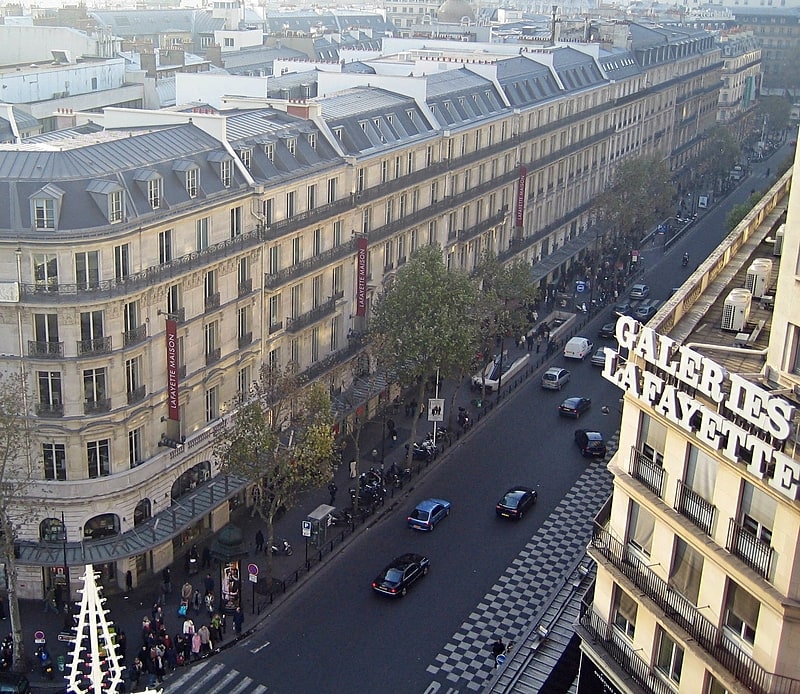
Street in Paris, France. Boulevard Haussmann, 2.53 kilometres long from the 8th to the 9th arrondissement, is one of the wide tree-lined boulevards created in Paris by Napoleon III, under the direction of his Prefect of the Seine, Baron Haussmann.
The Boulevard Haussmann is mostly lined with apartment blocks, whose regulated cornice height gives a pleasing eyeline to the Boulevard. The department stores Galeries Lafayette and Au Printemps are sited on this street.
From 1906 to 1919, the novelist Marcel Proust (1871–1922) lived at No. 102. There, in his cork-lined bedroom (now on display in the Carnavalet Museum), he wrote the major part of À la recherche du temps perdu. Alan Bates starred in 102 Boulevard Haussmann, a 1990 play written by Alan Bennett.
At 158 there is the Musée Jacquemart-André.
The Impressionist and patron of other artists Gustave Caillebotte (1848–1894) painted the Boulevard in many different lights as the days and seasons changed.
Marks & Spencer, the British department store chain, opened a store on Boulevard Haussmann in 1975 when it opened its first store in continental Europe.
In the Ian Fleming novel Thunderball, it is described as "the solidest street in Paris" and the site of the headquarters of SPECTRE.[35]
Address: Boulevard Haussmann, Paris (Élysée)